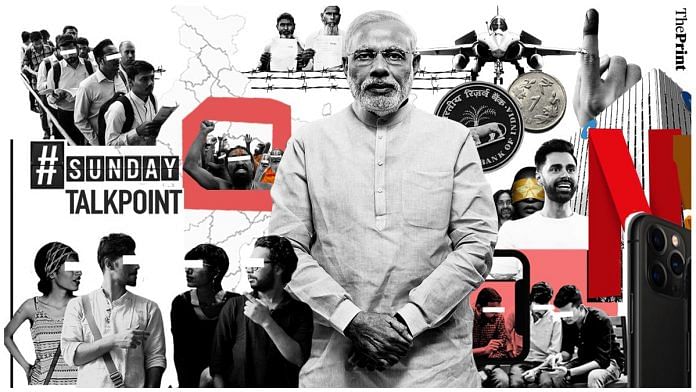As 2019 comes to a close, India has witnessed a momentous decade — the smartphone boom, proliferation of social media platforms and online streaming services like Netflix, the India Against Corruption movement, the rise of Narendra Modi, explosion of chartbuster Rs 100 crore-plus films, and so on. Breakthroughs in politics, culture, health, technology were plenty in this decade.
ThePrint asks: Modi to Netflix to smartphones: What changed India most in the last decade?
Politicians like Modi and Trump are beneficiaries, even products of the smartphone revolution
 Shailaja Bajpai
Shailaja Bajpai
Editor (Media) and Editorial Skill Development, ThePrint
There is no competition: the smartphone has changed society more than any single individual, movement or product. This is true for India and for the entire world, particularly in the last five years because data usage and connectivity costs have fallen appreciably.
Politicians like Indian Prime Minister Narendra Modi or US President Donald Trump are beneficiaries, even products of the smartphone revolution. It can be argued that the latter won the 2016 US presidential election with the help of Twitter, governs through Twitter and could well win the next presidential election with Twitter as his biggest weapon and ally.
Similarly, Modi and the BJP IT cell have targeted the public with the help of social media platforms, knowing that most people access Facebook, WhatsApp, email and Twitter through their smartphones. It is no coincidence that Trump and Modi have more than 50 million followers on Twitter, the only two incumbent world leaders to enjoy such popularity.
Smartphones have also revolutionised access to everything from communication to information and entertainment, typified by streaming platforms like Netflix as well as news consumption.
Through thousands of apps, smartphones offer personalised services for everything: from online shopping (Amazon, Flipkart), to home and personalised services like Urban Clap, food portals like Zomato and Swiggy, and the list is endless. Indeed, there is almost nothing that cannot be now accessed through smartphones.
The smartphone is the personal assistant we cannot live without.
Such has been the impact of brand Modi that politics & religion have engulfed everyday conversations
 Snehesh Alex Philip
Snehesh Alex Philip
Senior associate editor, ThePrint
There is no doubt that India has changed a lot in the last one decade. While smartphones have impacted the way we communicate with others besides providing endless entertainment through online videos, shows, games and movies, the rise of the power called Narendra Modi has changed India and its political discourse forever.
One can certainly argue whether his foray into national politics was for the good of people, the fact is that brand Modi and everything that comes with it, both seen and unseen, has impacted India in many ways.
The change had begun not from 2014 when he became the prime minister but from the time when he had set his eyes on New Delhi, which was even before the 2009 Lok Sabha election.
Modi’s rise has brought a huge difference in the lives of average Indians. Such has been the impact of Modi that politics and religion seem to have engulfed everyday conversations and debates now. Moreover, frenzied nationalism has replaced patriotism, and this could potentially have permanent repercussions for the socio-cultural fabric of India in the future.
From children to adults, it seems everyone is divided into two camps — for Modi or against Modi.
With meticulous planning and marketing, brand Modi has become a unifying factor for many but completely divisive for others.
It is the smartphone, not Modi or Netflix, that has changed India drastically in last 10 years
 Gaurav Singh
Gaurav Singh
Journalist, ThePrint
Smartphones have changed India immensely in the last ten years. Affordable smartphones along with low-cost data services havebrought millions of Indians online. Because smartphones have revolutionised the communication landscape of this country, there have been big changes in journalism as well as politics. But it’s the latter that has undergone a massive change.
In the last decade, social media platforms such as WhatsApp, Facebook, Instagram, Telegram, TikTok and Twitter grew exponentially and a new mode of political and election campaigning also grew along with it.
The youth of today are spending more time on social media through their smartphones. This is why the smartphone has become a good platform to spread any category of news, political or general. It has drastically altered the thinking of India’s youngsters and has broadened their horizons.
PM Narendra Modi makes good use of Twitter and Facebook to connect with people and convey his thoughts and policies. He recognises the power of smartphone-led technological revolution.
As social media platforms are easily accessible from smartphones, whose subscription rate in India has crossed the 400 million mark, it is smartphones not Modi and/or Netflix that have changed India. In short, smartphones have made the lives of Indians much easier now.
Not one person in India can say Modi didn’t impact life — for better or worse

Prashant Dixit
Senior copy editor, ThePrint
In a country of 1.3 billion people, Netflix has a subscriber base of about 2 million, many of whom would arguably be from the upper middle class. Smartphones, which indeed witnessed their biggest penetration among India’s growing mobile telephony industry in the last decade, are still somewhat of a luxury that a section can’t afford.
But there’s not one person in India who can say Narendra Modi and the path his government took didn’t impact his or her life in some form or the other — for better or worse. Mostly for worse.
Consider this simple fact: if you do not support Narendra Modi or his decisions, it’s a difficult life you live. All channels of airing your concerns are shut (for both poor and rich). Everything comes under question: your loyalty to India, your support for the minorities and the marginalised. From every institution to each citizen, an unquestioning support is not only expected but demanded. If you don’t support Modi and his government, you cannot say it because ‘where were you for the past 70 years’?
It is this sweeping reductiveness that has really, effectively changed India — and all of it started with the beginning of the creation of ‘Modi wave’ in 2013.
Also read: From Ikk Kudi to Ek Do Teen — the best & worst of Bollywood music this decade
By Kairvy Grewal, journalist at ThePrint







India has turned an essential corner, breaking away from elitist, dynastic politics. The electorate will have a better benchmark, and hopefully will not allow families to rule India like zamindars.
India has changed, without a doubt, in recent years. Whether for the better is difficult to say.